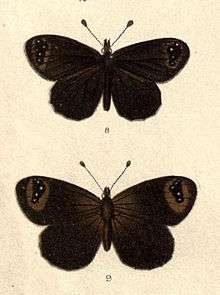Percnodaimon
Percnodaimon is a monotypic genus of satyrid butterflies in the family Nymphalidae. Its sole species, Percnodaimon merula, the black mountain ringlet, is endemic to New Zealand. Its Māori name is pepe pouri, which means "dark moth".
| Percnodaimon | |
|---|---|
 | |
| Male and female black mountain ringlets (Percnodaimon merula) | |
| Scientific classification | |
| Kingdom: | Animalia |
| Phylum: | Arthropoda |
| Class: | Insecta |
| Order: | Lepidoptera |
| Family: | Nymphalidae |
| Genus: | Percnodaimon Butler, 1876 |
| Species: | P. merula |
| Binomial name | |
| Percnodaimon merula (Hewitson, 1875) | |
| Synonyms | |
| |
Description
The species is considered to live about a year in its adult stage, but since the larvae can take two or three summers to grow to full size there is a possibility that it can live up to four.[1] It is thought that the extra growth duration is necessary for development required to inhabit the extreme climate and conditions of New Zealand's Southern Alps, in which they are found. They are known to be found at altitudes ranging from 800 to 2500 meters.[2]
The morphology of the butterfly also plays an important physiological role. Its dark wings coupled with its large surface area acts as a black body, and absorbs the electromagnetic energy from the sun's rays. By absorbing and storing heat, the wings of the black mountain ringlet butterfly essentially act like solar panels. This is another adaptation evolved for survival in the frosty conditions of the Southern Alps.
Life cycle
Ovum
The adult female black mountain ringlet deposits her eggs atop stones on the alpine slopes. When the sun is out it heats these stone's exposed surface, acting as an incubator for the eggs. This behaviour is unique among New Zealand butterflies and is only seen in a handful of butterfly species occupying the Himalayas and European Alps.
The eggs are initially blue, eventually turning speckled and brown, a feature evolved to blend in with the stony background. About two days before hatching begins this colouration is lost and the brown head of the larvae becomes visible. The hatching process takes around 12 days, but may take some time longer if the eggs are at higher altitudes. To sustain itself the newly-hatched larvae consume their egg casings as it contains the required nutrients for early larval stages.
Larvae
Larval colours can vary from dull grey to brown, but contain black anterior setae. The black mountain ringlet larvae have five instars which take about a month each in pleasant summer temperatures, but can take up to eight months if it occurs over winter. For this reason the butterfly can stay in its larval stage for up to two years and can be found almost year-round in an instar stage.
It was reported that, the small grass, Poa colensoi was a food source for these larvae. This grass is common throughout the Southern Alps, but it appears that the larvae are present only where the grass grows adjacent to rocky areas.[3] The black mountain ringlet larvae are known night feeders and have been spotted feeding on the tips of tussock blades. The larvae spend little time feeding, but instead choose to conceal themselves in nearby hiding spots. This is to prevent them being preyed upon by aerial predators, which can easily spot them atop tussock grass blades.
Pupa
At the start of pupation the black mountain ringlet turns grey with brown speckles to match the surrounding stones. During the actual process however, the butterfly has another interesting strategy; the pupae suspend themselves horizontally (unlike most butterflies) against the under surface of a rock and hold themselves to the surface by a cremaster, a hook shaped protuberance near the abdominal area. Pupae have been found up to 3 feet away from the nearest food plant and emerge as adult butterflies emerge 2 to 3 weeks later.
Imago
The wingspan of the imago can be between 4 and 5.5 cm and usually contains a black/brown colouration across the dorsal surface. One characteristic feature of this species is the black and white circles which appear at the distal-most end of the wings. Sexual dimorphism doesn't exist to a large degree, as both male and female have similar appearances. However, females tend to be a bit larger. A behaviour observed in the imago stage, especially on a sunny day is that they fly in zigzag patterns, taking advantage of the air currents and often glide in a "V" position.
Conservation
Not much research has been conducted on the black mountain ringlet, and although it is one of the few endemic species of butterfly New Zealand has, it is still a field where more can be learned from. Because they inhabit the intrepid Southern Alps, it is difficult to predict the exact distribution, but it is believed that they can be found through the mountain range.
See also
References
- "nzButterfly". Retrieved February 25, 2015.
- "Tepapa". Retrieved February 25, 2015.
- "The Life History of the Black Mountain Ringlet Butterfly Percnodaimon pluto Fereday" Archived 2015-01-21 at the Wayback Machine. G. W. Gibbs (1970). Retrieved March 3, 2015.
External links
- Black Mountain Ringlet at NZbutterfly.info